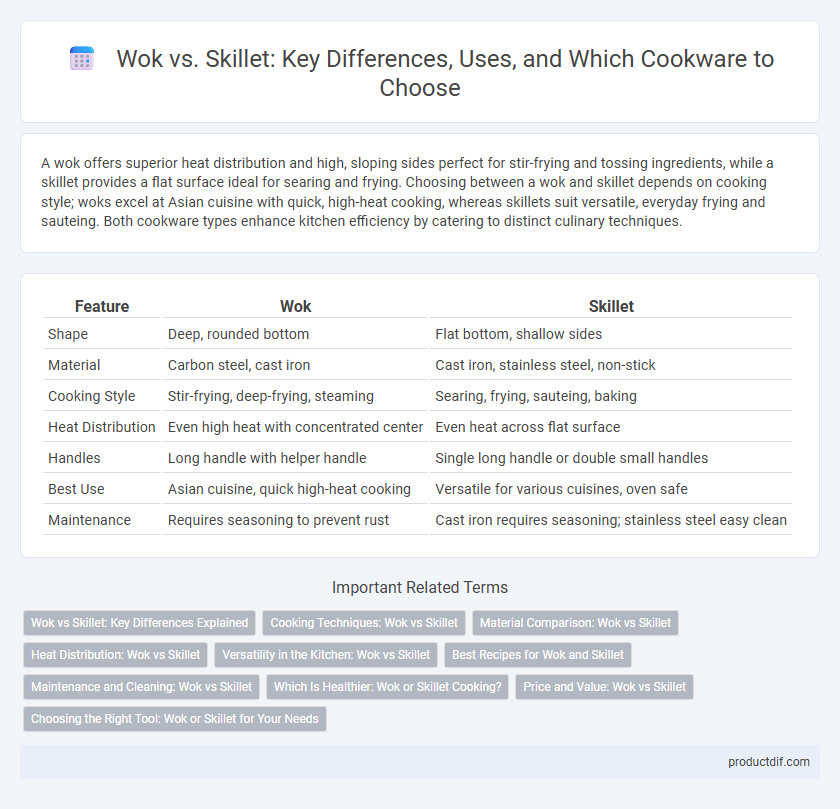A wok offers superior heat distribution and high, sloping sides perfect for stir-frying and tossing ingredients, while a skillet provides a flat surface ideal for searing and frying. Choosing between a wok and skillet depends on cooking style; woks excel at Asian cuisine with quick, high-heat cooking, whereas skillets suit versatile, everyday frying and sauteing. Both cookware types enhance kitchen efficiency by catering to distinct culinary techniques.
Table of Comparison
| Feature | Wok | Skillet |
|---|---|---|
| Shape | Deep, rounded bottom | Flat bottom, shallow sides |
| Material | Carbon steel, cast iron | Cast iron, stainless steel, non-stick |
| Cooking Style | Stir-frying, deep-frying, steaming | Searing, frying, sauteing, baking |
| Heat Distribution | Even high heat with concentrated center | Even heat across flat surface |
| Handles | Long handle with helper handle | Single long handle or double small handles |
| Best Use | Asian cuisine, quick high-heat cooking | Versatile for various cuisines, oven safe |
| Maintenance | Requires seasoning to prevent rust | Cast iron requires seasoning; stainless steel easy clean |
Wok vs Skillet: Key Differences Explained
Woks feature a rounded bottom and high, sloping sides designed for rapid stir-frying and even heat distribution, while skillets have a flat bottom and lower sides ideal for searing, frying, and sauteing. Materials often differ, with woks typically made from carbon steel for quick heating and skillets commonly constructed from cast iron or stainless steel for heat retention. The cooking techniques vary significantly; woks excel in tossing and fast cooking over high heat, whereas skillets provide stable surface area suited for browning and pan-frying.
Cooking Techniques: Wok vs Skillet
Woks excel in high-heat, quick stir-frying that requires constant movement and even heat distribution, ideal for tossing vegetables and proteins rapidly. Skillets provide steady, consistent heat suitable for searing, frying, and slow cooking, allowing for better browning and caramelization. Each cookware's design influences cooking technique efficiency, with woks promoting agile, high-temperature cooking and skillets supporting controlled, prolonged heat exposure.
Material Comparison: Wok vs Skillet
Woks are traditionally made from carbon steel or cast iron, offering excellent heat retention and rapid temperature changes ideal for high-heat stir-frying. Skillets commonly feature cast iron, stainless steel, or aluminum constructions, providing versatility for frying, searing, and even baking with even heat distribution. Carbon steel woks heat quickly and develop a natural non-stick patina, while cast iron skillets excel at maintaining steady temperatures for slow cooking.
Heat Distribution: Wok vs Skillet
Woks are designed with a rounded bottom that allows heat to concentrate at the base, providing rapid, high-temperature cooking ideal for stir-frying. Skillets, typically flat-bottomed, offer even heat distribution across the entire cooking surface, making them suitable for searing and frying with consistent temperature control. The difference in shape affects how heat spreads, with woks enabling quick, intense heat cycles and skillets supporting steady, uniform cooking.
Versatility in the Kitchen: Wok vs Skillet
Woks offer superior versatility in the kitchen with their unique shape, allowing for high-heat stir-frying, steaming, deep-frying, and even smoking, making them ideal for Asian cuisine and quick cooking techniques. Skillets provide consistent heat distribution suitable for searing, frying, baking, and sauteing, excelling in tasks requiring a flat cooking surface and even cooking. Choosing between a wok and a skillet depends on the cooking methods favored, with woks supporting fast, high-heat dishes and skillets excelling in versatile, all-purpose frying and browning tasks.
Best Recipes for Wok and Skillet
Woks excel in high-heat stir-frying recipes, perfect for dishes like vegetable stir-fries, fried rice, and noodle-based meals due to their deep, sloped sides that promote quick, even cooking. Skillets, especially cast iron ones, are ideal for searing, frying, and baking recipes such as steaks, pancakes, and skillet cornbread, providing excellent heat retention and a crispy crust. Choosing the right cookware enhances recipe outcomes by matching cooking techniques to the wok's fast, intense heat and the skillet's versatile, steady heat distribution.
Maintenance and Cleaning: Wok vs Skillet
Woks require seasoning to maintain their non-stick surface and prevent rust, necessitating careful hand washing without soap, followed by thorough drying. Skillets, especially cast iron or carbon steel variants, also demand seasoning but can tolerate occasional gentle soap use if re-seasoned properly afterward. Both cookware types benefit from avoiding dishwasher use to preserve their seasoning and extend lifespan.
Which Is Healthier: Wok or Skillet Cooking?
Wok cooking uses high heat with minimal oil, preserving nutrients and reducing fat absorption, making it healthier for stir-frying vegetables and lean proteins. Skillet cooking often involves longer cooking times and more oil or butter, which can increase calorie content and nutrient loss. Choosing a wok can promote healthier meals through quicker cooking at higher temperatures that retain flavor and nutrients.
Price and Value: Wok vs Skillet
Woks generally offer better value for high-heat, quick-cooking techniques due to their unique shape and construction, often priced between $20 to $100 depending on material and brand. Skillets, commonly cast iron or nonstick, range from $15 to $80 and provide versatile cooking options suitable for frying, sauteing, and baking, making them a budget-friendly staple. Choosing between a wok and skillet depends on cooking style preferences and long-term durability, with cast iron skillets typically offering superior longevity and resale value.
Choosing the Right Tool: Wok or Skillet for Your Needs
Selecting the right cookware depends on cooking style and dish requirements; woks excel in high-heat stir-frying with their curved shape promoting even heat distribution and fast cooking, while skillets offer a flat surface ideal for frying, searing, and sauteing with precise temperature control. Material composition, such as carbon steel for woks and cast iron or stainless steel for skillets, influences heat retention and durability, impacting performance based on your preferred cooking techniques. Evaluating factors like heat source compatibility, maintenance, and recipe type ensures you choose a wok or skillet that enhances culinary results efficiently.
Wok vs Skillet Infographic

 productdif.com
productdif.com